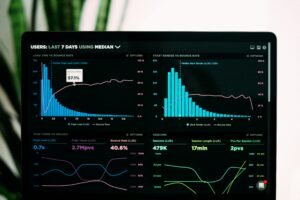Ever wondered if Business Intelligence (BI) and Analytics are just fancy buzzwords? Or do they actually offer different benefits? If you’re nodding your head, you’re in the right place! Let’s peel back the layers and compare analytics vs BI. By the end, you’ll know which tool can rocket your business decisions into the stratosphere. Ready to explore? Here’s the lowdown on how BI turns raw data into valuable insights, while Analytics takes it a step further by predicting future trends.
Definitions: Analytics vs BI
Business intelligence (BI) uses systems, methods, and tools to convert raw data into actionable insights, supporting both strategic and tactical decisions. Think of BI as reviewing a report card to evaluate past performance and identify areas for improvement. BI tools often create dashboards and reports that summarize historical and current data to guide real-time decisions.
Data analytics takes it further by focusing on collecting, analyzing, and interpreting data to uncover deeper insights and predict future outcomes. If BI evaluates past results, data analytics forecasts future trends using advanced techniques like statistical analysis and predictive modeling, helping businesses prepare for what lies ahead.
Functions and Tools of Analytics vs BI

BI tools focus on collecting and housing data on current operations. They help create dashboards and reports that give a snapshot of what’s happening now. Think of BI tools as the eyes and ears of your business, providing real-time insights. Tools like Power BI, Tableau, and Cognos allow businesses to visualize data through charts and graphs, making it easier to understand and act on.
Analytics tools dig deeper into the numbers. They use quantitative methods to predict future trends and outcomes. If BI tools tell you what happened, analytics tools tell you what might happen and why. Tools like Google Analytics and SAP Analytics Cloud analyze user behavior, market trends, and other data points to help forecast future performance and optimize strategies.
| Tool | Function | Example |
|---|---|---|
| Power BI | Data visualization | Creating interactive dashboards |
| Tableau | Data reporting | Generating detailed reports |
| Cognos | Business intelligence | Monitoring key performance indicators (KPIs) |
| Google Analytics | Web analytics | Tracking website traffic and user behavior |
| SAP Analytics Cloud | Predictive analytics | Forecasting sales and market trends |
Benefits of Business Intelligence and Analytics
BI helps in making smarter decisions by providing actionable insights from historical data. Imagine looking at a treasure map that shows where you’ve been and where the treasure might be. BI tools turn raw data into easy-to-understand dashboards and reports, making it easier for leaders to see what’s going on and act quickly.
Analytics offers predictive insights to optimize processes and strategies. It’s like having a crystal ball that tells you what might happen in the future. By using complex techniques like statistical analysis and predictive modeling, analytics tools help businesses forecast trends and prepare for what’s coming next.
Shared benefits of BI and analytics:
- Improved decision-making: Both BI and analytics provide insights that help make better business choices.
- Increased efficiency: They streamline operations by identifying areas for improvement.
- Competitive advantage: Stay ahead of competitors by using data to drive strategies.
- Enhanced customer satisfaction: Understand customer needs and behaviors better.
- Cost savings: Identify areas for resource optimization or reduction.
Comparative Analysis: Analytics vs BI

Use BI for real-time insights into current operations, like tracking sales or inventory through dashboards, to improve ongoing processes and make quick decisions based on past performance. Analytics, on the other hand, focuses on predicting future trends, using tools like predictive modeling for strategic planning and market forecasting.
The choice depends on your business goals, data maturity, and team expertise—BI is ideal for structured data and immediate actions, while analytics excels in long-term planning and uncovering future opportunities.
Comparing various aspects:
- Data Types: BI deals primarily with structured data; analytics can handle both structured and unstructured data.
- User Roles: BI is often used by business leaders and managers; analytics is more for data scientists and analysts.
- Goals: BI aims to understand current operations and improve them; analytics seeks to forecast future trends and optimize strategies.
- Complexity: BI tools are generally easier to use; analytics tools require advanced skills.
- Focus: BI focuses on reporting and monitoring; analytics emphasizes analysis and forecasting.
- Timeframe: BI looks at past and present data; analytics looks at future predictions.
Use Cases for Analytics vs BI
BI focuses on real-time reporting and performance management, using tools to track Key Performance Indicators (KPIs), streamline operations, and boost productivity through actionable dashboards. Analytics dives deeper, analyzing customer behavior, forecasting market trends, and optimizing processes to enhance marketing strategies, resource allocation, and long-term outcomes.
| Use Case | BI or Analytics | Description |
|---|---|---|
| Reporting | BI | Generating detailed reports on key metrics |
| Performance Management | BI | Tracking and evaluating real-time performance |
| Operational Efficiency | BI | Streamlining processes to reduce costs |
| Customer Behavior Analysis | Analytics | Understanding buying habits and preferences |
| Market Trend Prediction | Analytics | Forecasting future market trends |
| Process Optimization | Analytics | Identifying and eliminating inefficiencies |
Career Paths in Analytics vs BI

BI careers involve managing data and creating dashboards with tools like Power BI and Tableau, while analytics roles use advanced skills and tools like Google Analytics and SAS to predict trends. Salaries range from $60,000–$90,000 for data analysts and $70,000–$100,000 for BI analysts, with higher-level roles exceeding $120,000.
Key skills required for each path:
- BI:
- SQL proficiency
- Data warehousing
- Reporting and dashboard creation
- Data quality management
- Knowledge of BI tools (Power BI, Tableau)
- Analytics:
- Statistical analysis
- Predictive modeling
- Data mining
- Proficiency in analytics tools (Google Analytics, R)
- Strong mathematical skills
Choosing Between BI and Analytics
Deciding between BI and analytics depends on your business goals and data needs. BI is best for gaining real-time insights, monitoring current performance, and making immediate decisions using historical data to generate reports and dashboards. It’s ideal for operational tracking and quickly responding to issues. In contrast, analytics is better suited for predicting future trends and informing long-term strategies. By leveraging techniques like statistical analysis and predictive modeling, analytics helps forecast outcomes and guide strategic planning, making it essential for future-oriented decision-making.
Questions to consider when choosing between BI and Analytics:
- What are your primary business goals?
- How mature is your data infrastructure?
- Do you need real-time insights or future predictions?
- What is the skill level of your team?
- Are you dealing with structured or unstructured data?
Conclusion
We’ve unpacked the world of analytics vs BI. We started by defining analytics vs BI, then dove into their functions and tools. We also highlighted the benefits, did a comparative analysis, and explored real-world use cases.
At the end of the day, analytics vs BI both play crucial roles in business performance. While BI focuses on current operations, analytics predicts future trends.
Remember, whether you lean towards analytics or BI, the key is data-driven decision-making. Here’s to making smarter, insight-driven choices in your business!
FAQ
What is the difference between analytics vs BI?
The difference between analytics and BI lies in their focus areas. BI deals with descriptive analysis, summarizing historical data for reports and decision-making. Analytics, on the other hand, uses predictive models to forecast future trends and behaviors.
Is BI part of analytics?
BI is a subset of analytics. BI focuses on collecting, processing, and presenting historical data to inform business decisions. Analytics encompasses BI but also includes predictive and prescriptive analysis to guide future strategies.
Is BI the same as a data analyst?
No, BI is not the same as a data analyst. BI typically involves tools and systems to visualize data, whereas a data analyst interprets data and provides insights. Both roles often overlap but have distinct functions.
Analytics vs BI salary?
Analytics roles often command higher salaries due to the advanced skills required, such as predictive modeling. Business intelligence roles generally focus on data visualization and reporting, typically offering competitive but slightly lower salaries.




